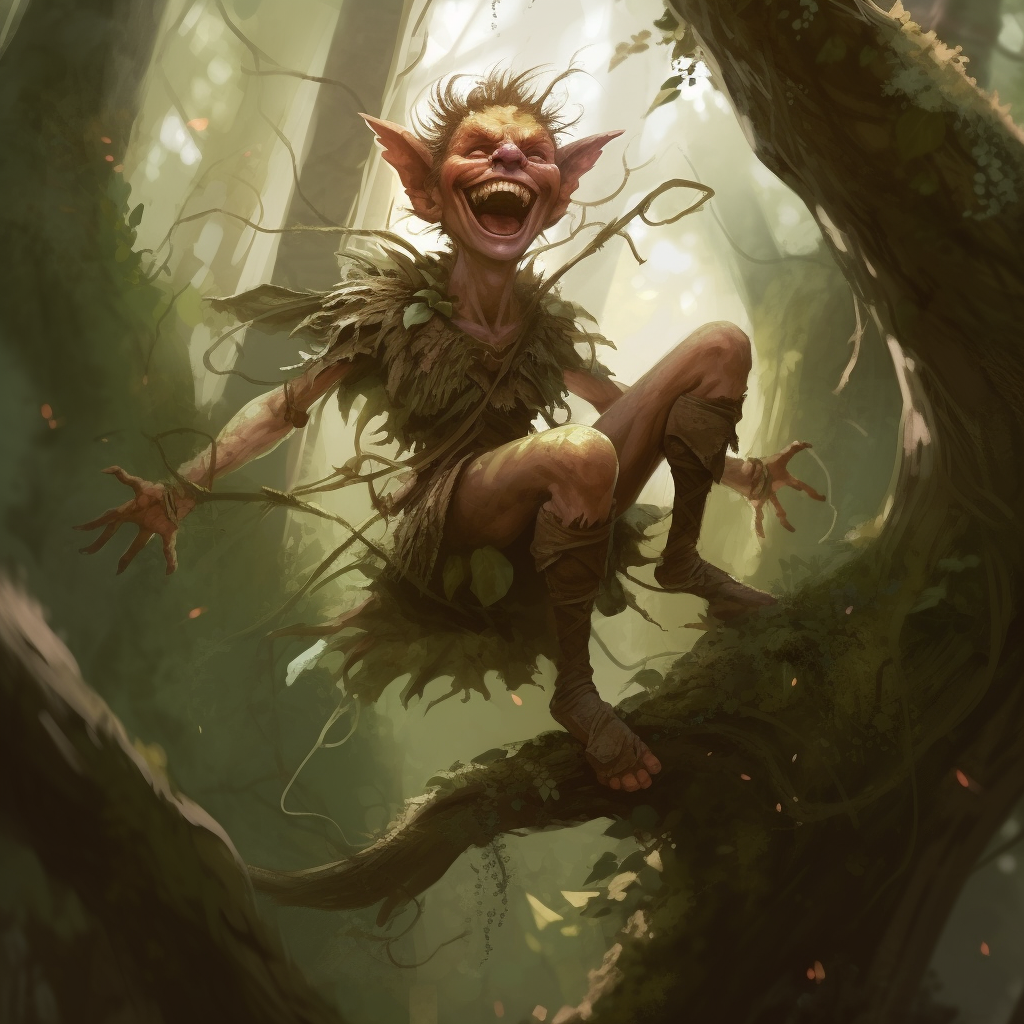Coté
Generative AI dominates VMware Explore news - AI uses in the VMware stack.
Developers Are the Future Of VMware (Part 2): Multi-Cloud and AI | by Torsten Volk - Good examples and thinking on using LLM AI in systems management stuff, in this case with VMware Tanzu and Aria.
I tried to get ChatGPT to summarize VMware Explore 2023 for me. I don’t know, it wasn’t that great. Also, a peak into my Dungeons and Dragons “ChatDM” obsession.
Rye Leafoot's Guide to Elderwood: The Lost Tribe
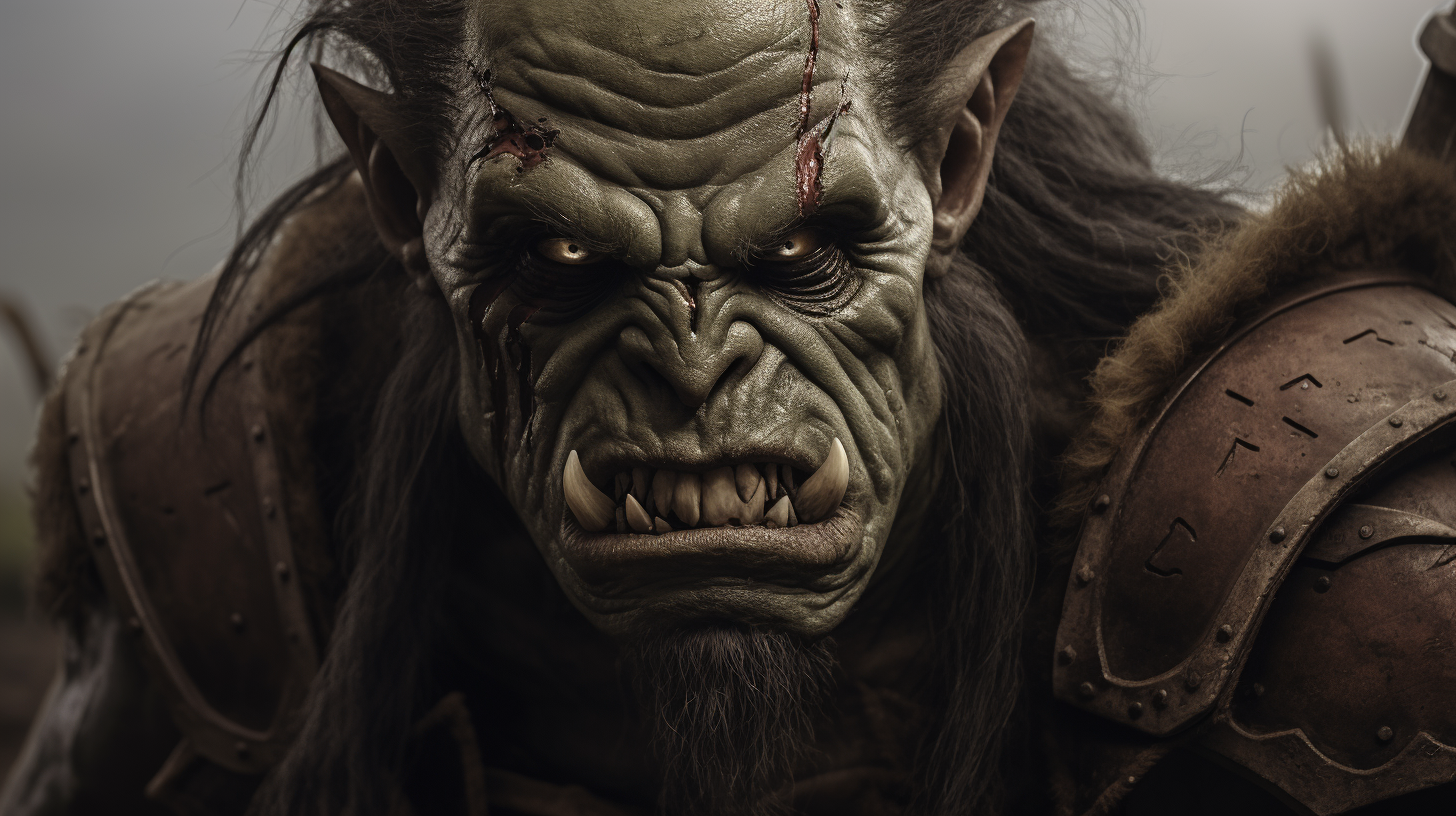
Preface
In the annals of Eldergrove’s tangled history, a formidable tapestry of culture and survival, one cannot overlook the enigmatic presence of The Lost Tribe. Nestled within the heart of this ancient forest, a society of orcs has taken root, upending both conventional orcish dogma and the limitations those who see them through eyes of ignorance. This monograph endeavors to peel back the layers of this unique tribe, piecing together the fragments of lore and legend that define their identity.
How upended, you may ask? They are governed not by the barking males of the species, but by the self stylized “Matriarks.” Eschewing the chaotic nature of traditional orcish society, they follow a rigorous code religiously. And speaking of religion, they not only shun the orc pantheon of Gruumsh, but believe any story of the one-eyed god to be fairy tales meant to weaken the tribe. But, most incredibly - and, as I will kindly do throughout, I tell you this for your own safety, you’re best not to say it this way should you ever converse with something other than the blade of a tribe member - the Lost Tribe embraces member who are not orcs. On this last point, I can’t help but add: you would be hard pressed to not think they were orcs.
Ever since I first heard tale of this tribe late one night in The Whispering Willow, my mind has been fixed on one question: how could this upending occur?
My belief is that The Lost Tribe’s dramatic origins forced the tribe to evolve.
First, some years ago the drow of the under-mountain decided that no other races should cohabitate with their vile selves. The drow, demonstrating that intelligence is no guarantee of civility, systematically wiped out countless orcish tribes and other residents of the hill. There are much more unkind words to apply to such a “war” that I will omit. The tribe calls this event The Crucible.
The drow’s utter destruction of the tribe leadership and warrior-cast of left the tribe both leaderless and gave them stark evidence that their traditional notions of strength were, to apply the strongest of orcish insults, weak. The handful of tribe members that remained were forced to flee.
Having fled south from the Elf’s Walls to the Elderwood, being a tiny minority populace our forest has forced the Lost to evolve core tenants of their society. “Tiny minority” - it’s best not to phrase the Lost as such as I found one night!
I for one, believe it is a an evolution for the better. As a guardian of the Elderwood, I’ve seen many of the towering triangle of the Lost Tribe stand among the tower trees of the wood. To my eyes, the two are indistinguishable.
The Triangle
Within the whispering depths of Eldergrove, a tribe of orcs stands as a testament to resilience and adaptation. Forged by hardship and driven from their mountain homes after a bitter defeat against the genocidal drow of the under-mountain, these orcs are now known as “The Lost Tribe.” 333 in number, they have woven themselves into the fabric of the forest, spreading across enclaves both large and small, emerging as an unexpected union of diverse races and backgrounds.
Matriarchal Evolution
From what I can glean, somewhere around 80 years ago - 84, the more numerological of the tribe will insist - the under-mountain drow’s relentless onslaught upended this tribe’s traditional orcish hierarchy. Most of the male leaders, once the cornerstone of orcish leadership, were either slain or captured by the drow. In the wake of devastation, a matriarchy emerged.
Now, under the mantle of “Lost Matriarks,” the females guide their tribe. At the apex stands the Blood Matriark, embodying both fierce warrior and cunning leader, proving her mettle annually or when challenged.
 Kanak, The First Matriark
Kanak, The First Matriark
Studying the society, culture, and mind of The Lost Tribe is like studying magics of a master illusionist gone mad. Nothing is as it seems, and the mage casting the spell cannot be relied on for a coherent explanation. Proud as they are, a member of the tribe only ever has one reason to explain their nature: strength. Very few will abide inquiry about origins.
However, in a few rare conversations I have all but confirmed my suspicions. Because the fleeing tribe was so lacking in the male members of the species and the shamans who passed down their traditional beliefs, their new society evolved both, I believe, in blood and in brains. As an often repeated saying of The Lost Tribe says: “the enemy’s blade culls the weak, clearing a way for the strong to answer."
And, dear reader, you will delight in knowing that there are many, many sayings of The Lost Tribe. I will share some with you as we go, and have endeavored to collect those I know in an appendix. However, I have counted well over 500 now and am endeavoring to capture them all in a subsequent volume.
The Blood Code
Struggling to survive the aftermath of the drow genocide, and then as immigrants in an unfamiliar realm, The Lost Tribe evolved into lawful society. The necessity to survive led to the crystallization of a strict, unyielding code, The Blood Code. Though it may appear brutal to outsiders, the code is the tribe’s moral compass. This distinction sets them apart from the broader orc religion and culture, further fueling their sense of defiance, pride, and to my belief, strength and adaptability.
The Crucible birthed a strict code that governs every facet of their existence. This code, both brutal and unwavering, anchors them in their collective identity. Every tribe member, from birth, is indoctrinated into the Code’s tenets. The tribe attributes the code’s early inception to their salvation, standing as a defiant testament to their resilience.
The Blood Code of Three Threes TK( this should be in sets of 3 )
- 𐑮𐑃𐑎 𐑎𐑗𐑝𐑊𐑞𐑑𐑗𐑑𐑉𐑊𐑝 (Respect blood, honor the tribe)
- 𐑑𐑎𐑑𐑗𐑇𐑇 𐑃𐑎𐑏𐑑𐑉𐑑𐑒𐑑 (Stand together, forged by annihilation)
- 𐑝𐑠𐑙𐑍𐑕𐑎𐑎 𐑊𐑍𐑎𐑗𐑙𐑃𐑊𐑠 (Give strength, share strength)
- 𐑏𐑑𐑉𐑊𐑝 𐑑𐑑𐑞𐑋𐑑𐑛𐑇𐑗 (Defend honor, wield valor’s blade)
- 𐑞𐑋𐑑𐑛𐑇𐑗 𐑍𐑕𐑍𐑠𐑝𐑊𐑛 (Crush the witless, build strength)
- 𐑃𐑎𐑏𐑑𐑉𐑑𐑒𐑑 𐑎𐑓𐑛𐑏𐑑𐑠𐑎𐑎 (Craft legacy, shape destiny)
- 𐑃𐑎𐑏𐑑𐑉𐑑𐑒𐑑 𐑞𐑉𐑠𐑎𐑛𐑑 (Victory in strength, strength in threes)
- 𐑑𐑗𐑑𐑙𐑎𐑇𐑇 𐑏𐑕𐑍𐑏𐑑𐑞𐑃𐑊𐑠 (Forge the three, steel binds)
- 𐑗𐑑𐑊𐑝 𐑑𐑗𐑑𐑑𐑗𐑑𐑊𐑗 (The Code is strength, eternal strong)
Triumvirates of Governance
 Councils of three, composed of revered orcs, govern the sub-tribes. These councils oversee daily governance, with a higher council above them, beneath the authority of the Blood Matriark. Guided by the Blood Code, the system's simplicity favors clarity and speed, making for swift decisions. The Blood Matriark retains the right to override, challenge, or ignore council decisions, though typically, harmony prevails.
Councils of three, composed of revered orcs, govern the sub-tribes. These councils oversee daily governance, with a higher council above them, beneath the authority of the Blood Matriark. Guided by the Blood Code, the system's simplicity favors clarity and speed, making for swift decisions. The Blood Matriark retains the right to override, challenge, or ignore council decisions, though typically, harmony prevails.
The Triangle of Blood, Unwavering Companionship
Orc of the Lost Tribe are only ever seen in sets of three. This is known as a “Blood Triangle.” Aside from the hidden moments when orcs are ensconced with families, the triangle the smallest group of orcs you’ll ever seen. To see a single orc outside of the confines of an orc camp signifies that something has gone awry.
I have yet to discover when these triangles are formed, but from guarded responses to my queries, they appear to be life-long bonds between the three. Some ritual binds them, and, I suspect, as with all oaths and rituals of The Lost Tribe, an exchange of blood likely takes place. Indeed, the three call each others “Blood Kin” and adopt fanciful names for their group. The rest of the Lost will often refer to triangle, rather than a specific orc.

When you meet them in full splendor, the triangle is a formidable sight — two heavily armored orcs bearing orcish greatswords, each known as a render, accompanied by a third wielding a longsword and an orcish longbow, known as the blood seeker. The later serves as a ranged observer, barking strategic observations, suggesting tactics, and, of course, seeking blood from afar.
Curiously, the Blood Matriark has no triangle. I have yet to discover why.
The Tribe is Blood
Perhaps the most delicate part of my study has been learning about the foundlings role in The Lost Tribe. Common in other societies, a “founding” is a child that has been, well, found by one of the tribe. This may be by accident, though more than you would suppose, it is on the battlefield.
These foundlings are oft not actual orcs. Curiously, they are often children of those the orcs have slain. I have become, well, one does not say “friends” about members of the tribe, but, rather, I have had the chance to speak on multiple occasions with many of these foundlings. Thus far, all but three have been humans. Aside from physical characteristics, they are indistinguishable from the rest of the Lost.
Indeed, the foundlings status appears to be as such to the, if you’ll pardon the phrase, true orcs of the Lost Tribe.
Early on in my study of the Lost when I was a bit more cavalier with my questions, I asked one of the orcs in the Crimson Whisper triangle how one of their points, the human Kelda (the blood seeker), thought of her position biologically in the society. Her silence was captivating, and unnerving. It caught me off guard, and as I tried to recompose myself, I found that Qrald the One Fang, had suddenly hoisted my small halfling frame up eye-to-eye, demanding to know on which trees I would like various parts of brains spread on. It was only with a dramatic braking from Kelda that Qrald set me down.

“They do not see what you see,” Kelda said, having shifted from the orcish I had only heard her speak to a rough use of our Common Tonge. She hesitating every so slightly, looking at me with those dull blue eyes of hers, “nor what I can see. They see only orc.” She then proceeded to do something I had never experienced and have yet to experience again: she smiled at me! It was not, I fear, a jovial smile, however. It was then that I noticed that all of her teeth that could be seen has been filed to jagged points, some layered with metal and, thus, pulled into tiny daggers.
After that, dear reader, I learned to never see the distinction myself, least seeing eye-to-eye with a member of the Lost became the last thing I ever saw.
Delicate Diplomacy
The Lost Tribe maintains an uneasy peace with Aurel’s Reach, once embroiled in clashes that have given way to mutual non-interference. Many decades ago, before my arrival in the forest, a rare alignment of threat from across the Sea of Passage saw the Lost align with the popular of Aurel’s Reach in combat.
Lost Tribe orcs venture to the city occasionally, always in threes, causing surprise and caution, but rarely alarm and combat.
Of late, there is a more permanent pretense of The Lost Tribe in Aurel’s Reach. One triangle known as the Matriark’s Voice resides permanently in the city, serving what we would call “diplomats,” a word the Lost don’t seem to have in their vocabulary.
Notable Blood Tribe Members
Blood Matriark Kanak the 3rd
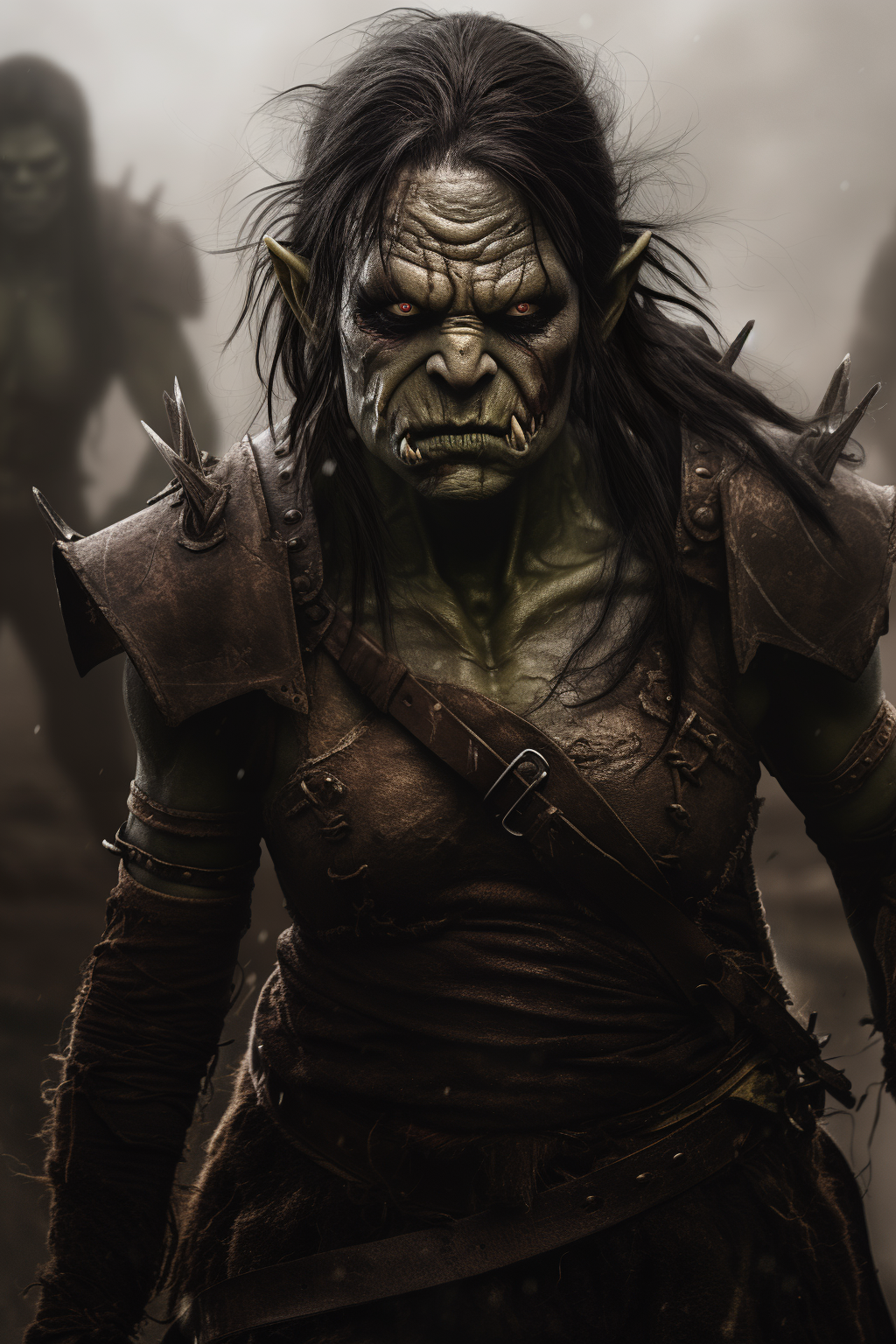 Kanak the 3rd, descendent of the first is the current Blood Matriark of the tribe. Guided by flames both visceral and metaphorical, she commands with a blazing resolve. Kranark’s rise to power was written in dragonfire—the scalding crucible where she and her triangle fought with the previous Blood Matriark’s against a mighty wyrm that had invaded the tribe’s main camp. Drawing the dragon away from the camp, Kranark’s triangle and the Matriark eventually defeated the creature late into the night. But it was a trial beneath the weeping moon, all but the Blood Matriark and Kranark were killed by the dragon.
Kanak the 3rd, descendent of the first is the current Blood Matriark of the tribe. Guided by flames both visceral and metaphorical, she commands with a blazing resolve. Kranark’s rise to power was written in dragonfire—the scalding crucible where she and her triangle fought with the previous Blood Matriark’s against a mighty wyrm that had invaded the tribe’s main camp. Drawing the dragon away from the camp, Kranark’s triangle and the Matriark eventually defeated the creature late into the night. But it was a trial beneath the weeping moon, all but the Blood Matriark and Kranark were killed by the dragon.
Amidst the still-bleeding dragon’s carcass, seeing her opportunity, Kranark challenged the Blood Matriark. Despite both being severely injured by the dragon fight, Kranark defeated the Matriark to ascend as the new Blood Matriark by code. She has been the longest serving Blood Matriark and is as ruthless as she is devoted to the code and the tribe.
While she may not appear to be the strongest of all orcs, she is the craftiest and wisest of all Lost that I have met. Her intelligence can seem like magic to the other orcs. Paired with with speed and cunning, she is believed indomitable.
The Red Whisper
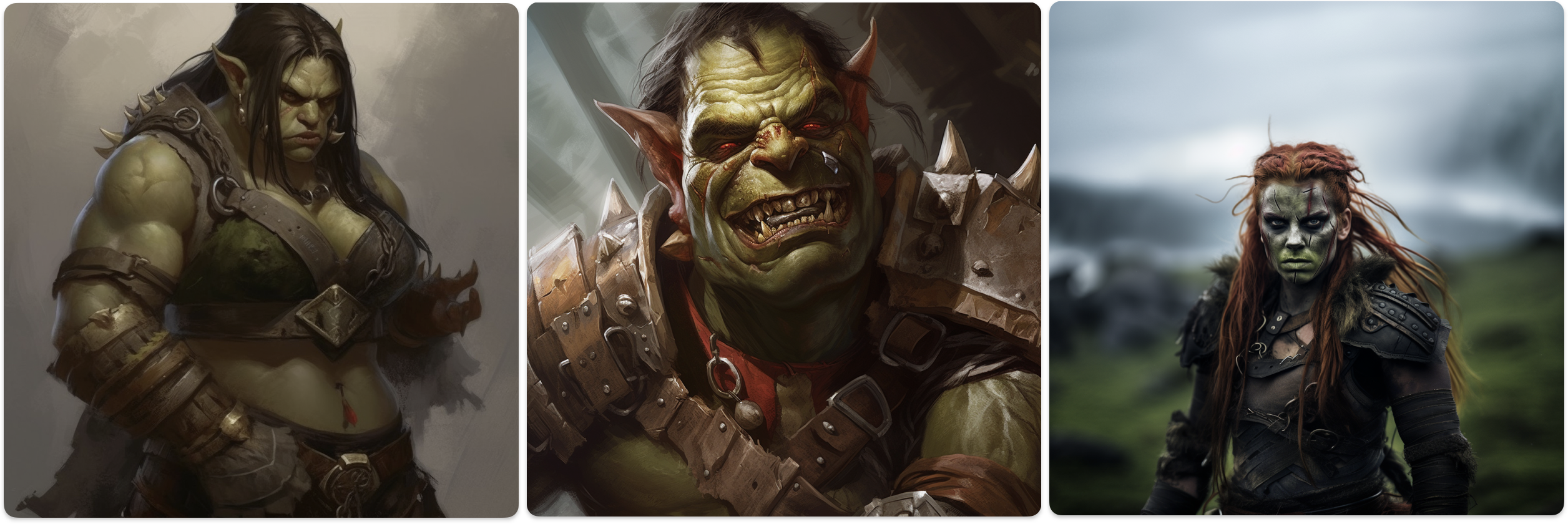 A small “camp” of just one Blood Triangle, Rokar Bloodblade, Qrald the One Fang, and Kelda Shadowarrow patrol the north east forest as the advance watch against drow. Though rare, drow occasionally come up from the under-mountains. Thanks to the Red Whispers, few have survived passage into Elderwood.
A small “camp” of just one Blood Triangle, Rokar Bloodblade, Qrald the One Fang, and Kelda Shadowarrow patrol the north east forest as the advance watch against drow. Though rare, drow occasionally come up from the under-mountains. Thanks to the Red Whispers, few have survived passage into Elderwood.
This trio embodies the tenacious heart of The Lost Tribe. And I’ve learned much about how the tribe works, how it thinks from them:
Fierce Loyalty: Even with their frequent bickering - very frequent bickering - the bond between Kelda, QRald, and Rokar unbreakable. Their mutual trust and reliance on each other are evident in their synchronized movements, non-verbal communication, and shared responsibilities. For the Lost Tribe, loyalty isn’t just a virtue; it’s a way of life.
Fluid Hierarchies: While Kelda often takes charge due to her assertive nature and larger view of the battlefield as the blood seeker, leadership within The Red Whisper is fluid. Depending on the situation, each member steps up to lead, leveraging their unique strengths for the benefit of the group. Rarely have I seen them confer on any issue, seeming to intuit what each other would think and do.
Adaptable Tactics: The Lost Tribe is not rigid in its battle strategies. Encountering drow marauders requires adaptability. Depending on the situation, they might use guerrilla tactics, set up ambushes, or, at times, even choose to avoid conflict, always prioritizing the tribe’s greater good.
Society, Family, and Roles
 There are 333 tribe members, varying from time to time. The Lost Orcs gather in camps, spread throughout the Elderwood but in regular contact. Camps range in size from as little as one triangle, to the many triangles of the Blood Matriark’s camp, The Crimson Hearth.
There are 333 tribe members, varying from time to time. The Lost Orcs gather in camps, spread throughout the Elderwood but in regular contact. Camps range in size from as little as one triangle, to the many triangles of the Blood Matriark’s camp, The Crimson Hearth.
Family
With the close bonds of the triangle, I at first thought it was the basis of family. This was just a naive outsider’s thoughts, however. Like most humanoids, member os the Lost have families of parents and children.
I have yet to be given view into this aspect of the Lots’s lives, though I have seen many orc children and, of course, foundlings. True to orcish nature, I would not call the few interactions I’ve seen with children to be “loving,” but there is clearly a bond and a type of kindness with children if you observe long enough.
When I have been many weeks into encamping with the Lost I have seen members of triangles separate from the other two to disappear for days into the deeper parts of the camp, presumably to be with their families.
Division of Labor
No matter how warlike, a resilient society cannot be all warriors. I have found the following major roles in The Lost Tribe.
Bloodcarved: Warriors
“My blood-soaked steel makes your flesh weak, the sounds of your death are the tribe’s triumph.”
This mighty assembly embodies the thunderous heartbeat of the tribe. Their ranks are composed of both male and female warriors, each wielding valor like a blade. Battle-scarred and unyielding, they stand ready to safeguard their homeland against any adversary.
Shadow’s Embrace: Hunters, Scavengers, Rogues, Assassins
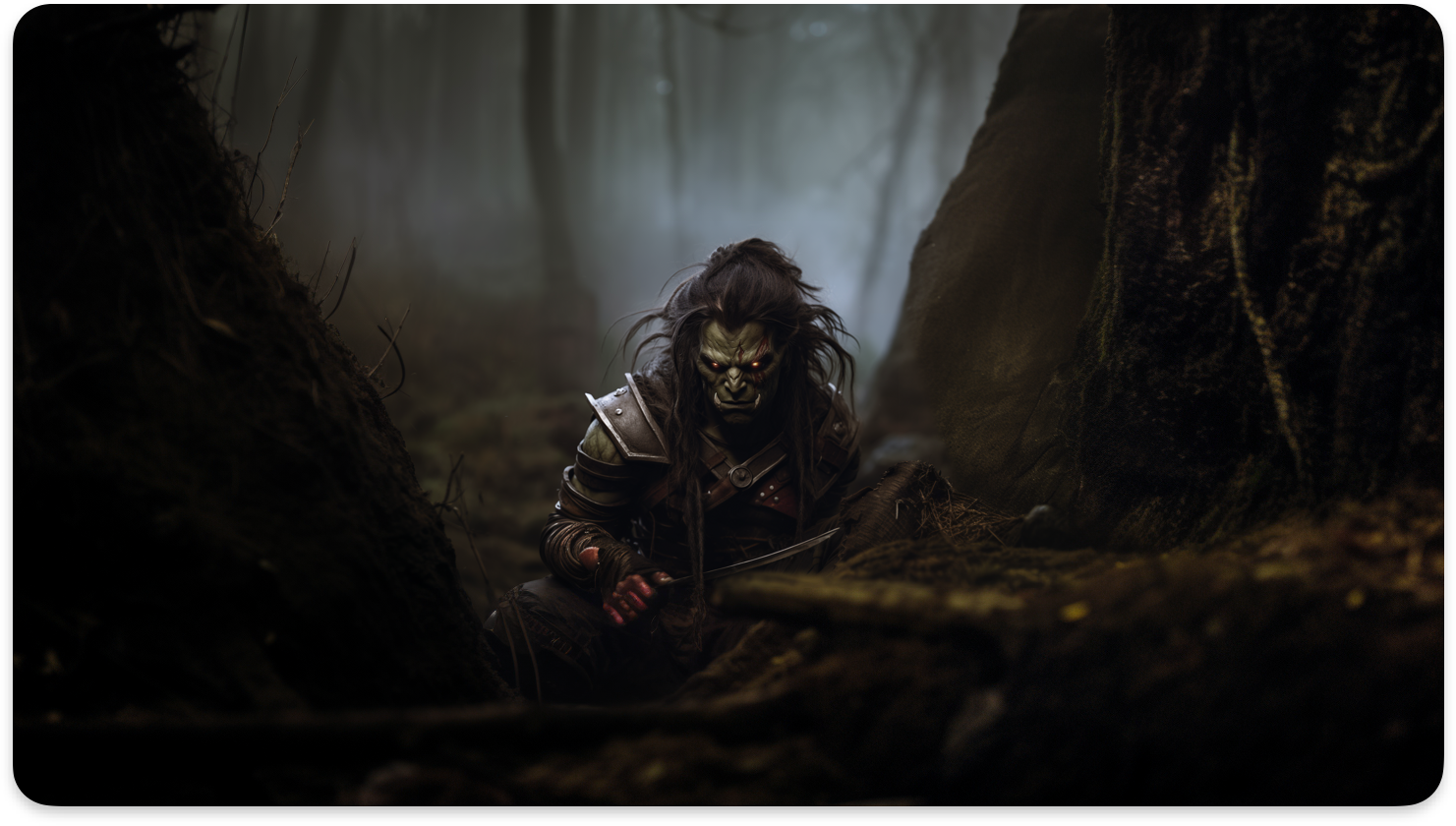 "I stare into my prey's eyes as they falter. Their terror lingers, seasoning the feast."
"I stare into my prey's eyes as they falter. Their terror lingers, seasoning the feast."
These agile orcs master the art of stealth and guile, flourishing in roles as hunters, scavengers, rogues, and assassins. Cloaked in shadows, they dance with the forest’s secrets, stalking prey (and enemies) with precision and striking from the veil of darkness.
Forgefires of Destiny: Blacksmiths and Artisans
 “Driving the hammer’s blows, our hands weld each Blood Triangle in steel.”
“Driving the hammer’s blows, our hands weld each Blood Triangle in steel.”
Within the tribe’s beating heart lies the forge, tended by skilled blacksmiths and artisans. With sweat and skill, they shape weapons, armor, and tools that resonate with the ancestral fire of their people. Each piece carries a history, a legacy, and the promise of victory.
Healers of Resilience: Healers and Herbalists
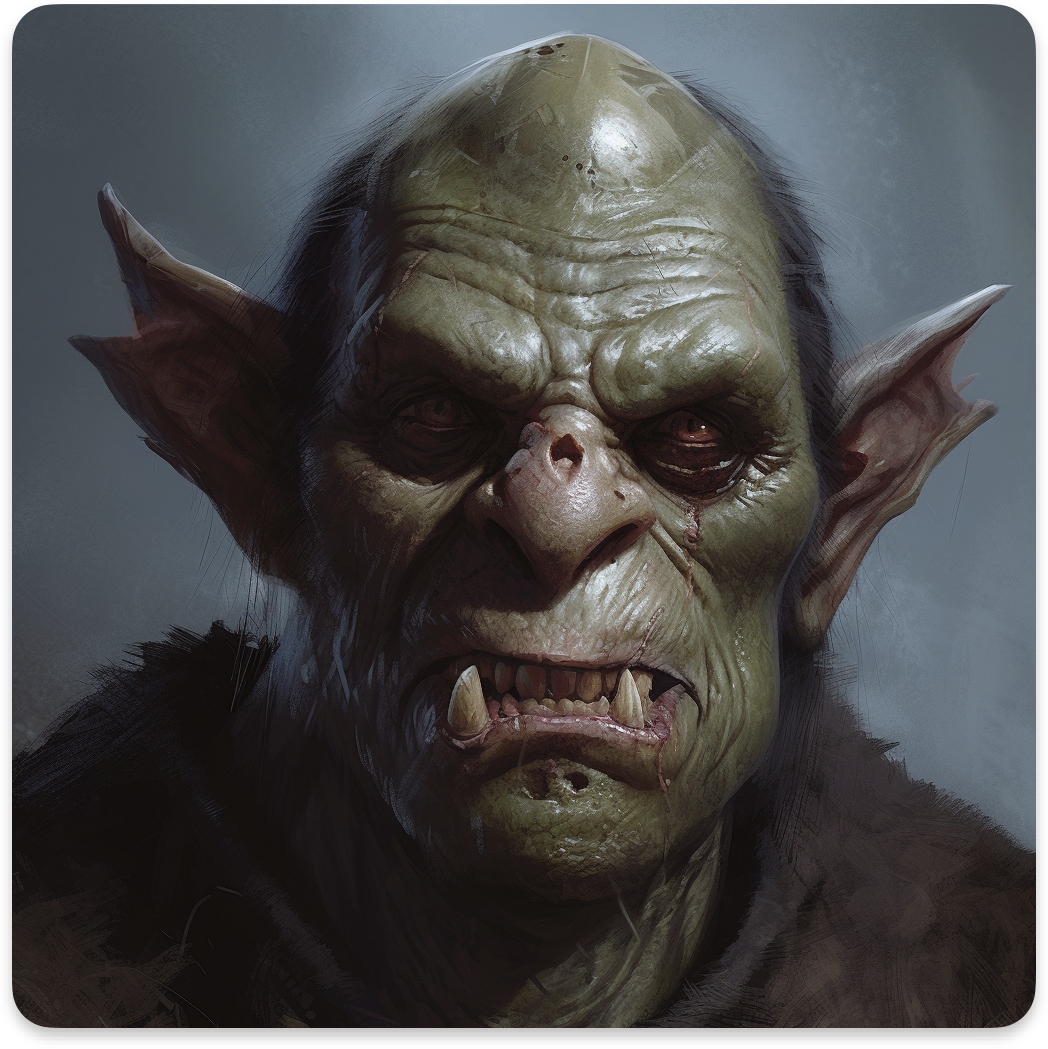 In the aftermath of battle, these healers mend the wounded, ensuring the resilience of the tribe. With herbs and salves, they nurse warriors back to health, embodying the spirit of unwavering strength.
In the aftermath of battle, these healers mend the wounded, ensuring the resilience of the tribe. With herbs and salves, they nurse warriors back to health, embodying the spirit of unwavering strength.
Reapers: Ranchers, Farmers and Gatherers - A tireless
The reapers bear testament to the tireless labor of these orcs, nurturing crops and gathering forest treasures. Meat, fruits, and grains sustain both body and spirit, binding the tribe to the land they call home. The larger camps maintain yards and glades of livestock from chickens, pigs, goats, and even steer.
Generations in Unity: Families and Children
Within familial bonds, the next generation blossoms, nurtured on tales of valor and unity. These children, snarling-laughter echoing through the tribe, are seeds that will grow into future warriors, carrying forth the tribe’s legacy.
Silent Echoes: The Lost Tribe’s Fading Faith
 “Ever silent, Gruumsh’s strength is a lie. The tribe washes away Gruumsh’s betrayal with the blood of the feeble.”
After the annihilation of the mountain orcs by the drow, The Lost Tribe greatly resented [Gruumsh and the other orc gods](https://forgottenrealms.fandom.com/wiki/Orc_pantheon). The orc pantheon seemed totally absent from the struggle with the drow. With the male leadership and shamans killed by the drow, The Lost Tribe slowly lost reason to worship the orc pantheon. Eventually, the tribe lost all faith in any divine orc. As if to prove that the orc gods abandoned them, nothing has been heard from the those gods since.
“Ever silent, Gruumsh’s strength is a lie. The tribe washes away Gruumsh’s betrayal with the blood of the feeble.”
After the annihilation of the mountain orcs by the drow, The Lost Tribe greatly resented [Gruumsh and the other orc gods](https://forgottenrealms.fandom.com/wiki/Orc_pantheon). The orc pantheon seemed totally absent from the struggle with the drow. With the male leadership and shamans killed by the drow, The Lost Tribe slowly lost reason to worship the orc pantheon. Eventually, the tribe lost all faith in any divine orc. As if to prove that the orc gods abandoned them, nothing has been heard from the those gods since.
The Lost have a reverence for the forest, but to say they worship the forest would be incorrect. The orcs see the forest as a force on its own, but more often a weapon, as one saying goes: “the forest finds blood just as quick as steel.” There is no denying the magical energy of the forest, which the rare orc druid harnesses. But the orcs have an utter lack of faith in anything spiritual.
Strength, valor, and survival are the only three things the Lost can be said to “worship.” As the orc saying goes: “the orc that listens to the gods’ lies shows their fear to face the flesh and bone standing before them.”
A popular Lost Tribe children’s bed time story
Qrald the One Fang told me this one night after I’d plied the Red Whisper with enough golden mead to lay an army of dwarves low.
In the old days when our tribe was settling in the Elderwood, a triangle found a hidden cave where the orcs here long before us and long gone worshiped Gruumsh. As nights turned to weeks, one of the triangle Rina was consumed by the stories of Gruumsh she had witnessed in the shrine. Each night, she secretly ventured back to the shrine alone, breaking her Blood Triangle in secret. So long did she turn her mind to Gruumsh the one-eyed, that she honored him in the old way by gouging out her own eye.
That same night, while she felt the witless ecstasy of One-Eye, a group of marauding drow attacked her camp. The drow destroyed three triangles, leaving only her own broken Blood Triangle. Unknowing of the consequence of her betrayal, Rina stumbled back to camp, weak from her pride in Gruumsh. She witnesses the drow slay her blood kin, draining their necks like stupid hogs. Each was strong as any member of the Lost. But, as only two, weak as an elf child’s bones.
Rina was enraged at the cowardly slaughter of her blood kin, but more so, her own fault in breaking the triangle. As the drow surrounded her for the kill, she yelled out in her weak voice, beseeching Gruumsh’s aid. The drow softly chuckled, it is said.
Her stance changed to a warriors’, crouched down, her hands of iron around her brute sword. As she licked the blood trickling from her enraged eye socket she said “Do you hear it, vile elves? There is no answer from the lies of Gruumsh. There is only answer from my steel" and slaughtered the drow single-handedly.
Thus we say: “the orc that sees with one eye drinks the blood of their triangle.”
It is said that the nine skulls that adorn the Blood Matriak’s throne are those of the slain drow.
Lost Tribe Sayings
With the code at the core of the Tribes essence, they each know and use hundreds of sayings, frequently as if to guide their thoughts and, thankfully, for those outside the tribe, make their intentions and thoughts clear.
- Poetry is the shield of the weak.
- Talk of dreams is talk of trash.
- The weak interrupt with words, the strong interrupt with blades.
- A compliment oft hides a knife.
- Talk of oneself is a distraction from talk of your enemy.
- When you show one who complains their entrails, they have but one complaints left.
- The enemy’s blade culls the weak, clearing a way for the strong to answer.
- Screamed or whispered, what is said before steel slices is meaningless.
- Mercy’s touch leaves a blade.
- Do not ask questions of the Matriark unless her reply is the last thing you wish to hear.
Half-Harpy, Dungeons and Dragons Race
A half-harpy is the result of a human breeding with a harpy. Usually, the offspring is a harpy (female), but 10% of the time the offspring is a half-harpy. Half-harpies are male 90% of the time, have wings, human arms, human hands but with long talons on each finger, and, as with a harpy, legs that start as human but end in vulture like ankled and feet.
Half-harpies are accepted into harpy society, but have an even deeper wanderlust than regular harpies. Half-harpies do not stay with flocks of harpies for long, but will follow the flock on annual migrations. A half-harpy that stays in one place for more than a month must roll a constitution DC of 10 each day or lose the ability to fly until it moves at least a day’s travel away from that location.
Diet
Half-harpies inherit the vulture-like diets and eating habits of harpies. Half-harpies eat an almost carnivorous diet and prefer uncooked meat of any type. They prefer eating rotten meat and other carrion. When it sees raw meat of any type, the half-harpy must roll a wisdom DC of 10 or be forced to eat a small portion of the meat, needing to be forcefully held back. To eat, the half-harpy rips its food apart and is resistant to eating with civilized manners. A half-harpy can eat vegetation but does not like it and needs to eat a large portion of meat at least once a week if it doesn’t regularly eat meat.
Relations to Humanoids
Most humanoid react cautiously to half-harpies. While tolerated, at the least provocation most humanoids will become fearful and hostile to the half-harpy. In such cases, roll a contest on charisma versus wisdom to see if the troubled humanoid becomes hostile. Smaller to medium sized (a wolf), non-sentient animals will immediately be afraid of half-harpies and flee, hide, or fight as the situation and their disposition determines.
Half-harpies are always chaotic, but may be good, neutral, or evil. The most common alignment is chaotic neutral.
Abilities
- Half-harpies increase dexterity by 2, and charisma by 2. Half-harpies are thin boned and light so they suffer a -2 to constitution.
- Age. As “unnatural” creates, half harpies mature quickly but die younger. Half-harpies are mature at 10 and can live up to 50 years.
- Languages. Half-harpies speak, read, and write, common, Auran (humanoid bird language), and one other language.
- They lose the siren song of harpies, but are highly immune to charm (they have an advantage), and totally immune to harpy songs and charms of other avian creatures.
- Half-harpies have full harpy wings and can fly at 30 ft, but walk a speed of 20ft. They must be wearing light armor or less, and no shield. To fly, a half-harpy can only carry half of the encumbrance for an equivalent human, or is forced to make a strength check each time it takes aloft.
- Half-harpies have darkvision and have detailed, long range vision. They can see a three foot carcass from four miles away.
- Half-harpies have perception, acrobatics, and deception.
- Half-harpies are particularly effected by freezing cold and roll and defend at a disadvantage for cold related checks.
Flying
Half-harpies fly at 30 feet and walk at 20 feet.
It takes a half-harpy one turn to get aloft, and a turn to land safely. The half-harpy’s feet talons need something to grip so, for example, it cannot land on a sheer, vertical surface that has nothing to grip onto.
If a harpy falls it takes damage as per a human falling the same feet.
Combat
Half-harpies can only use weapons that are two pounds or less. They can only use light armor. This armor must be specially made, increasing the cost by 50%.
Half-harpies can attack with their hand talons as slashing weapons, creating d4 damage. They can attack with their feet talons creating d4 damage plus their strength bonus. They can perform a special attack by quickly descending on a foe from 15 feet and striking with their feet talons for d6 + 3 damage.
While flying, if a half-harpy is hit, it must roll a Constitution. If it fails, it falls out of the sky and must roll a Dexterity check or 13, or take damage per the falling damage of a human.
A harpy will not attack a half-harpy unless directly provoked.
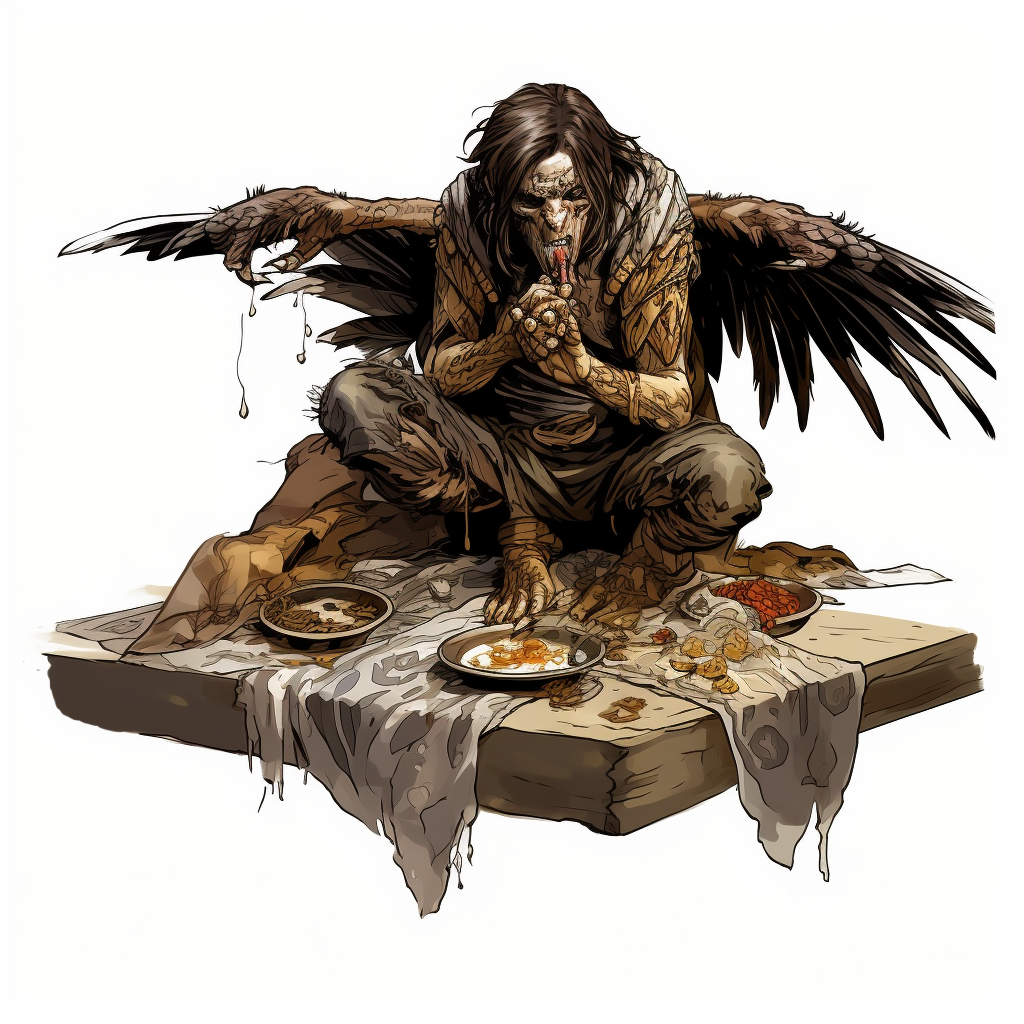
The Lost Ingredient - An Elderwood Adventure
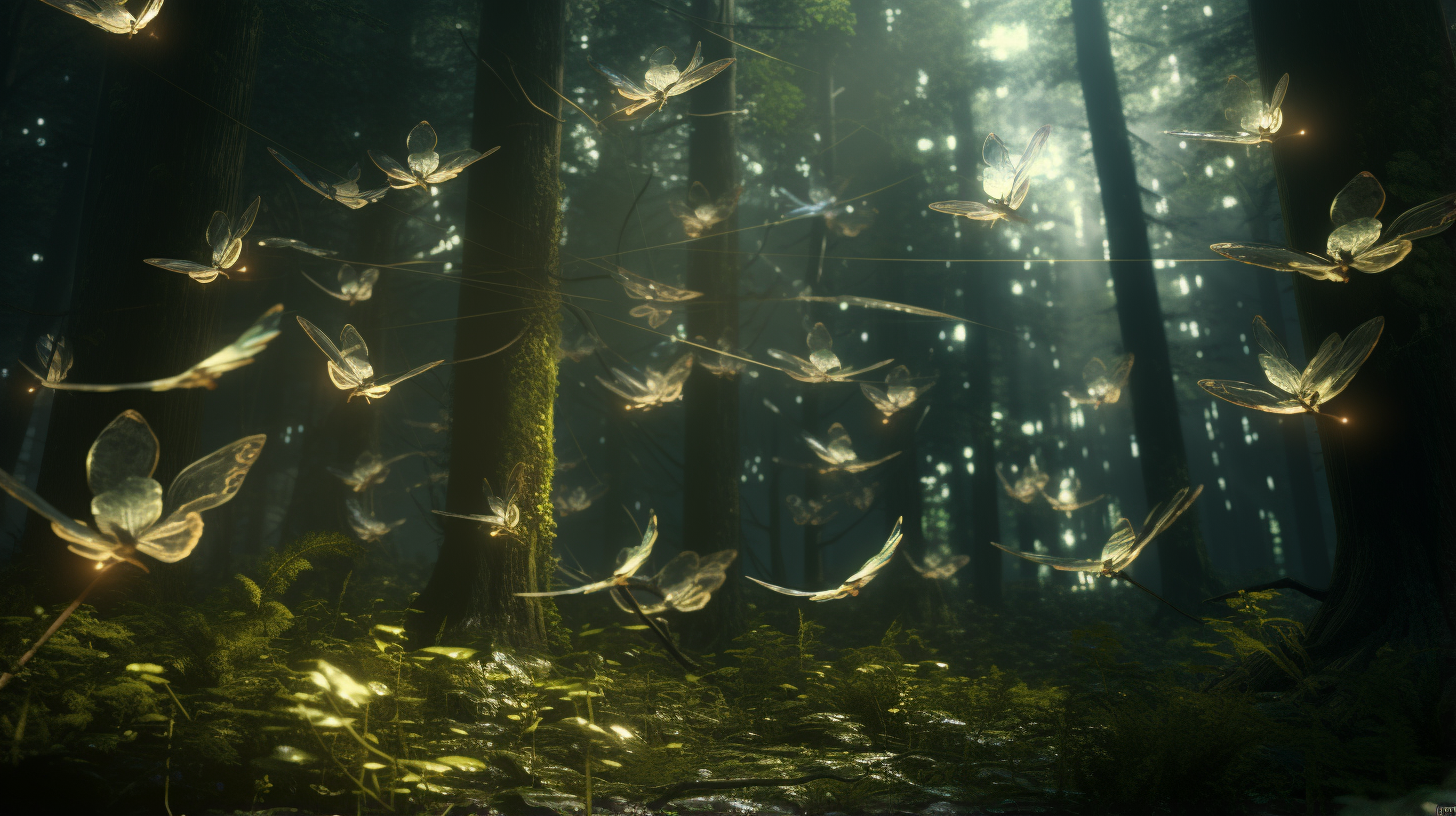
Overview
The Lost Ingredient is an adventure that takes place in the city of Aurel’s Reach and the surrounding Elderwood. The player, a new apprentice to Thanlin, a powerful but forgetful elven alchemist, is tasked with finding a rare ingredient, the Luminescent Elder Lily, for a potion that Thanlin has been brewing. The adventure involves seeking guidance from Rye Leafoot, a friend of Thanlin’s, retrieving stolen truffles, and negotiating with a tribe of pixies.
The Setup
Thanlin explains to the player that he’s lost the lily. Thankfully, his friend Rye can locate where to find more in the Elderforest. Thanlin sends the player to the Whispering Willow to ask Rye for help.
Part 1: Seeking Rye’s Guidance
Read to player
As you step into the Whispering Willow, the warm glow of lanterns and the cheerful hum of conversation welcome you. At a corner table, you spot Rye, engrossed in a book, a half-eaten pie forgotten next to him.
DM Overview
Rye is happy to cast Locate Animals or Plants for the character to find the lily. However, he needs the material component, a bit of fur from a bloodhound. More importantly, he’s just overheard that there’s a new delivery of truffles at Underwood’s Delights, a store in the east district market.
“It’s just one basket,” he says with a distressed look on his face. “I can start the ritual for the spell now, but I must get a few of those truffles before they’re out.” He hands the player 20 gold pieces and says, “get the truffles first, and then find the bloodhound hair. The constables’ kennel should have plenty - they might even pay you to take it!”
The player finds their way to Underwood’s Delights and managed to buy the last four truffles for 20 gold pieces. As they leave, an orc child runs into them and with a scared look runs off.
The orc child has stolen the truffles! The player will notice almost immediately. It won’t be hard to track down the orc child as there aren’t that many of them. If the player gets to them quickly, they can just demand them back. After some bluster, the child will hand them over.
If it takes longer, the child will have run into a building that has been painted crimson red. This is the new embassy of The Lost Tribe, an orc tribe of the Elderwood. There are three orcs inside (known as a “triangle,” they never separate). Use the standard orc statblock, but two carry two handed swords and the third a longbow and longsword. The orcs speak common and are more “civilized” than stock orcs, but still as blustery and brutal. If the player explains their case, one of the orcs will question the orc child, get the truffles, and give them to the player.
Once the player has the truffles, and they return them to Rye, he will finish casting the spell and draw a map for the player to the hidden glade. If the player can wait, Rye will offer to buy the player a fish in truffle sauce dish for the player after sending the truffles back to the kitchen.
Part 2: Journey to the Glade
Read to player
As you leave the city outskirts, the familiar sounds of Aurel’s Reach fade into the distance, replaced by the harmonious symphony of the Elderwood. The path before you is a winding trail through towering trees and lush undergrowth, the air filled with the earthy scent of moss and damp leaves. Dappled sunlight filters through the dense canopy above, casting a mosaic of light and shadow on the forest floor.
You cross a bubbling brook, its clear waters sparkling in the sunlight. The stones beneath your feet are smooth and worn, a testament to the countless travelers who have crossed here before. The path then leads you up a gentle slope, the forest growing denser and the air cooler as you ascend.
Suddenly, a rustling in the underbrush grabs your attention. You pause, your senses heightened, ready for whatever the forest might throw at you. But it’s just a squirrel, scampering away with an acorn clutched tightly in its paws.
You continue your journey, the forest around you alive with the sounds of chirping birds and the rustling of leaves. The path narrows and the trees grow closer together, their branches interweaving to form a natural archway. As you pass under it, you feel a sense of anticipation building, as if the forest itself is holding its breath.
DM Overview
The glade is north west of Aurel’s Reach, and should take about half a day. The map is surprisingly accurate, though it does not always show the easiest way.
While going down a narrow path, the player will encounter the player will encounter a giant spider, first encountering a dense web that fills the path.
Should the spider capture the player, they will be rescued by a three orcs from The Lost Tribe. These orcs will cruelly joke about the player’s weakness, one of them gnawing at a spider leg, but will roughly dust off the player and let them go. If the player is an elf, they will give them a playful (to an orc!) kick in the pants to send them off.
The spider has three cocooned bodies in its net: dead human and dwarf guards (leather armor, daggers, long swords, and common gear), but a still live tax collector with a bag of 150 gold coins, papers authorizing tax collection, and a record book of two years of tax collections for the past five years. If the orcs rescued the player, they will have taken all of this and freed the tax collector, leaving them unconscious but free.
More terrain:
- City Outskirts: As the player leaves Aurel’s Reach, they pass through the city outskirts, where the hustle and bustle of the city gives way to the serene outskirts. Here, they might see small homesteads, farmlands, and the occasional roadside inn or shop.
- Elderwood Forest: The player must traverse the dense and enchanting Elderwood Forest. This ancient forest is filled with towering trees, thick underbrush, and a network of animal trails. The forest is home to a variety of creatures, both friendly and hostile.
Part 3: The Glade and the Pixies
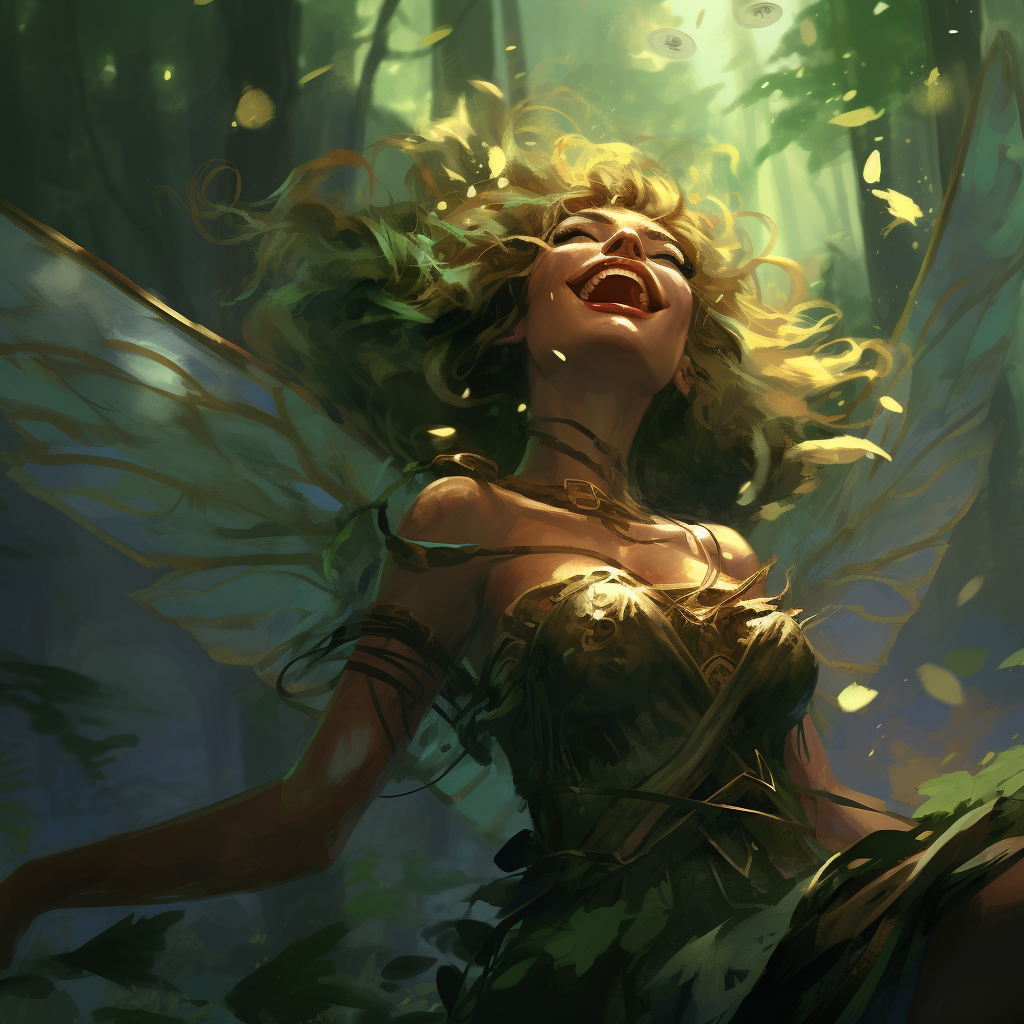
Read to player
As you push through the last curtain of hanging ivy and moss, the forest suddenly opens up into a breathtaking glade. The air here feels different, imbued with a quiet magic that makes your skin tingle. Bathed in a soft, ethereal glow, the glade is a symphony of color, the luminescent Elder Lilies casting dancing shadows that turn the ordinary into the extraordinary.
An ancient tree, gnarled and wise, stands sentinel in the heart of the glade, its branches reaching out like a silent invitation. The tree is surrounded by a tranquil pool, the water’s surface shimmering with the reflected light of the Lilies.
As you take a step further into the glade, you notice odd insects flitting about, their wings iridescent in the glow of the Lilies. They buzz and hum, adding a soft undertone to the symphony of the glade. It’s a sight to behold, a hidden gem nestled in the heart of the Elderwood, untouched and unspoiled.
DM Overview
As the player enters the Luminescent Elder Lily glade, they encounter a tribe of five pixies. These tiny, whimsical creatures live in the glade, and while they don’t value the Lilies themselves, they are intrigued by anyone who does. The player’s interest in the Lilies presents an opportunity for the pixies to engage in one of their favorite pastimes: bartering.
DM Instructions
“A song, a story, or a shiny trinket. That’s our price for a Lily."
- Pixie Introduction: Describe the pixies as they flit around the glade, their iridescent wings catching the glow of the Lilies. The pixies are curious and playful, but also cautious of the player. They watch from a distance, whispering amongst themselves, before one of them, bolder than the others, approaches the player.
- Pixie Bartering: The bold pixie, acting as the spokesperson for the tribe, expresses interest in why the player wants the Lilies. Once the player explains their need, the pixie proposes a trade. The trade could be for a shiny trinket, a heartfelt story, or even a song - pixies love music and are easily swayed by a good performance. If the player agrees to the trade and meets the pixies' request, they allow the player to take a few Lilies.
- Pixie Interaction: Encourage the player to interact with the pixies. The pixies might ask the player about their adventures, share some of their own stories, or even offer some advice or warnings about the forest. This interaction can add depth to the encounter and make the glade feel like a living, breathing part of the world.
See also pixie tricks and nonsense talk.
Adventure Conclusion
Once the player has satisfied the pixies, they will allow them to take three, or even ten, Luminary Lily. The player then safely returns to Aurel’s Reach if they choose to.
Upon giving the Licht Lelie to Thanlin he will proclaim, “wonderful, wonderful!” and then drop the Lilly into a beaker full of translucent brown liquid. The liquid will poof. “Finally! You’ve helped me perfect my recipe for transparent tea!”
Pixie Mischief
Pixies, those delightful and mischievous denizens of the Elderwood, are as much a part of the forest as the trees and the streams. Tiny and whimsical, they flit through the undergrowth, their wings aglow with an ethereal light. They are guardians of the forest, protectors of its secrets, and masters of trickery and illusion. Their laughter is the rustle of leaves, their whispers the sigh of the wind. They are elusive, yet their presence is felt everywhere.
Pixie mischief is legendary in the Elderwood. They are known for their playful pranks, their harmless tricks designed more to amuse than to harm. They delight in leading the unwary astray, in causing mild confusion and chaos, in adding a touch of whimsy and unpredictability to the otherwise serene forest. But remember, their tricks are never malicious, and often, they serve to remind us not to take life too seriously.
In my time in the Elderwood, when I’ve been, let’s say, lucky enough to encounter Pixies, I’ve collected a list of their delightful mischief. It’s a testament to their playful nature, a glimpse into their whimsical world, and perhaps, a guide on what to expect when you find yourself in the heart of their domain.
–From Rye Leafoot’s _Elderwood Guidebook, vol. 5: Catalog and Observations on the Least Dangerous of the Inhabitants of the Elderwood_.
When a player encounters a Pixie in Dungeons and Dragons, what might the Pixie do and say to mess with the player?
Twenty Pixie Pranks (d20)
- Pixies turn invisible and whisper misleading directions, leading people astray.
- They tie shoelaces together when no one’s looking.
- Pixies use minor illusion to create the sound of a roaring beast nearby.
- They sprinkle pixie dust on sleeping individuals, causing them to levitate a few inches off the ground.
- Pixies use their magic to make a person’s food taste like mud.
- They steal small, shiny objects and hide them in hard-to-reach places.
- Pixies use their magic to make a person’s clothes change color.
- They use minor illusion to make a rock look like a precious gem.
- Pixies move a person’s equipment around when they’re not looking.
- They use their magic to make a person’s hair stand on end.
- Pixies use minor illusion to create the sound of a swarm of bees.
- They use their magic to make a person’s voice sound like a frog’s croak.
- Pixies rearrange signs or landmarks to confuse travelers.
- They use their magic to make a person’s drink taste like vinegar.
- Pixies use minor illusion to make a tree look like a scary monster.
- They steal a person’s map and replace it with a drawing of a pixie sticking out its tongue.
- Pixies use their magic to make a person’s backpack unbearably heavy.
- They use minor illusion to make a harmless bunny look like a dire wolf.
- Pixies hide a person’s weapons and replace them with flowers.
- They use their magic to make a person’s bedroll feel like it’s filled with pebbles.
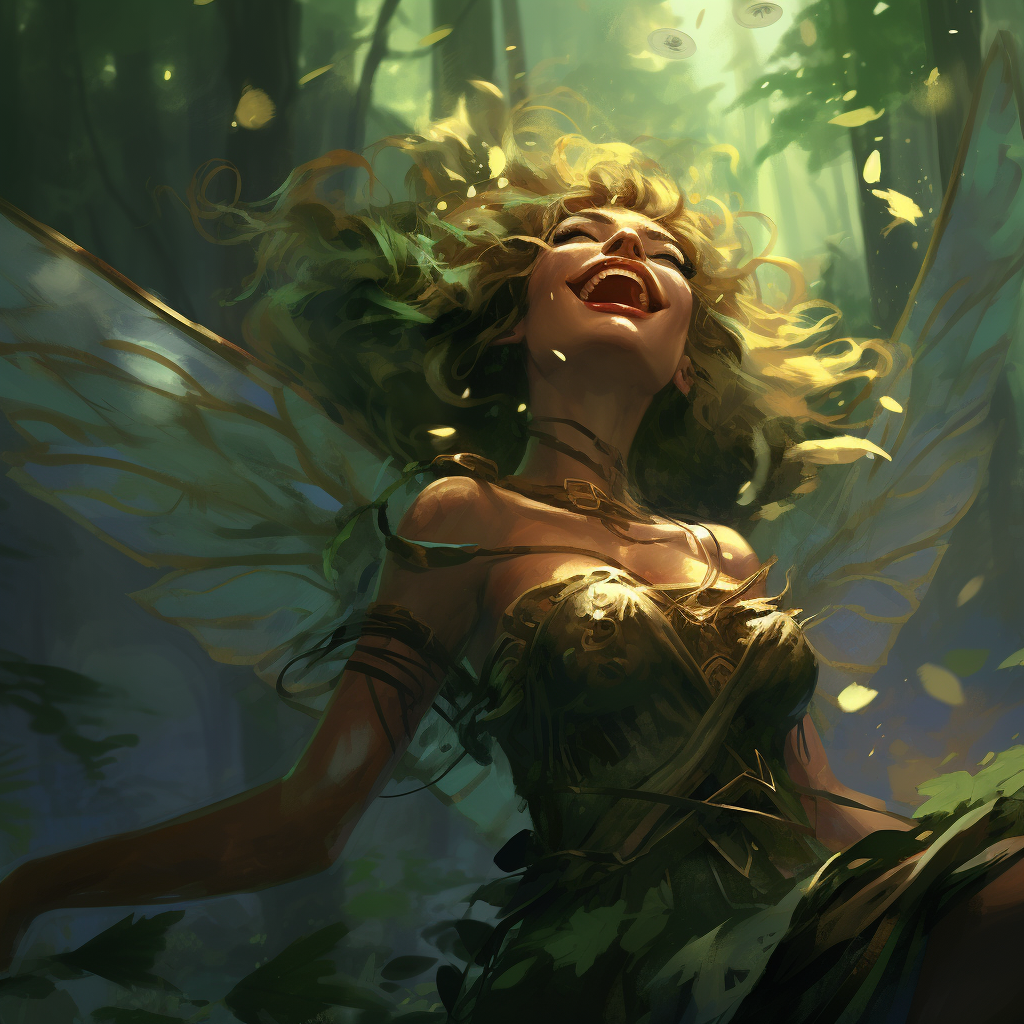
Pixie Nonsense Talks (d20)
“Just let me go and I’ll tell you a secret that the big folk don’t know!"
- “Did you know that cloud gazing at midnight helps you grow taller?”
- “The sun actually rises in the west in the Elderwood, you know.”
- “If you hold your breath while crossing a stream, you’ll become invisible.”
- “Trees can hear your thoughts, so be careful what you think around them.”
- “If you sing to your food, it tastes better. Trust me.”
- “Swallowing a pebble will make your voice sound like a dragon’s roar.”
- “Tying your boots with your eyes closed brings good luck.”
- “If you can catch a falling leaf before it hits the ground, you’ll have good dreams tonight.”
- “Walking backwards wards off evil spirits.”
- “If you whisper your secrets to a flower, it will never tell.”
- “Did you know that owls are actually afraid of the dark?”
- “Rubbing moss on your skin helps you blend in with the forest.”
- “You can talk to squirrels if you learn their language.”
- “Rainbows are actually bridges to other worlds.”
- “If you tickle a tree, it might just tickle you back.”
- “The moon is made of cheese, but only on Tuesdays.”
- “If you dance in the rain, you’ll never get wet.”
- “Birds can’t actually fly; they’re just really good at jumping.”
- “If you can catch a raindrop on your tongue, it will grant you a wish.”
- “Never trust a rabbit; they’re notorious liars.”
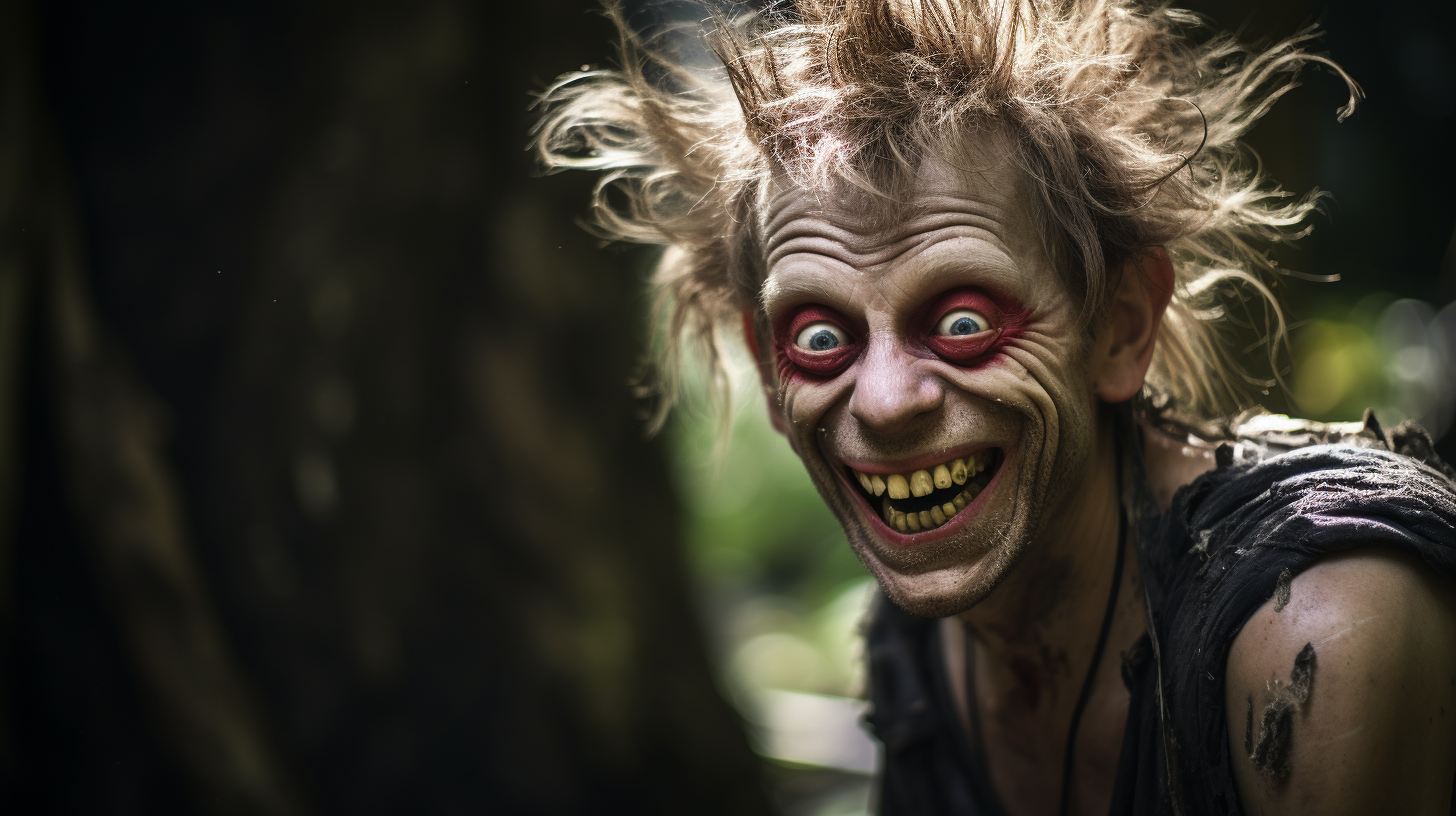
Rye Leafoot's Guide to Elderwood: The Whispering Willow
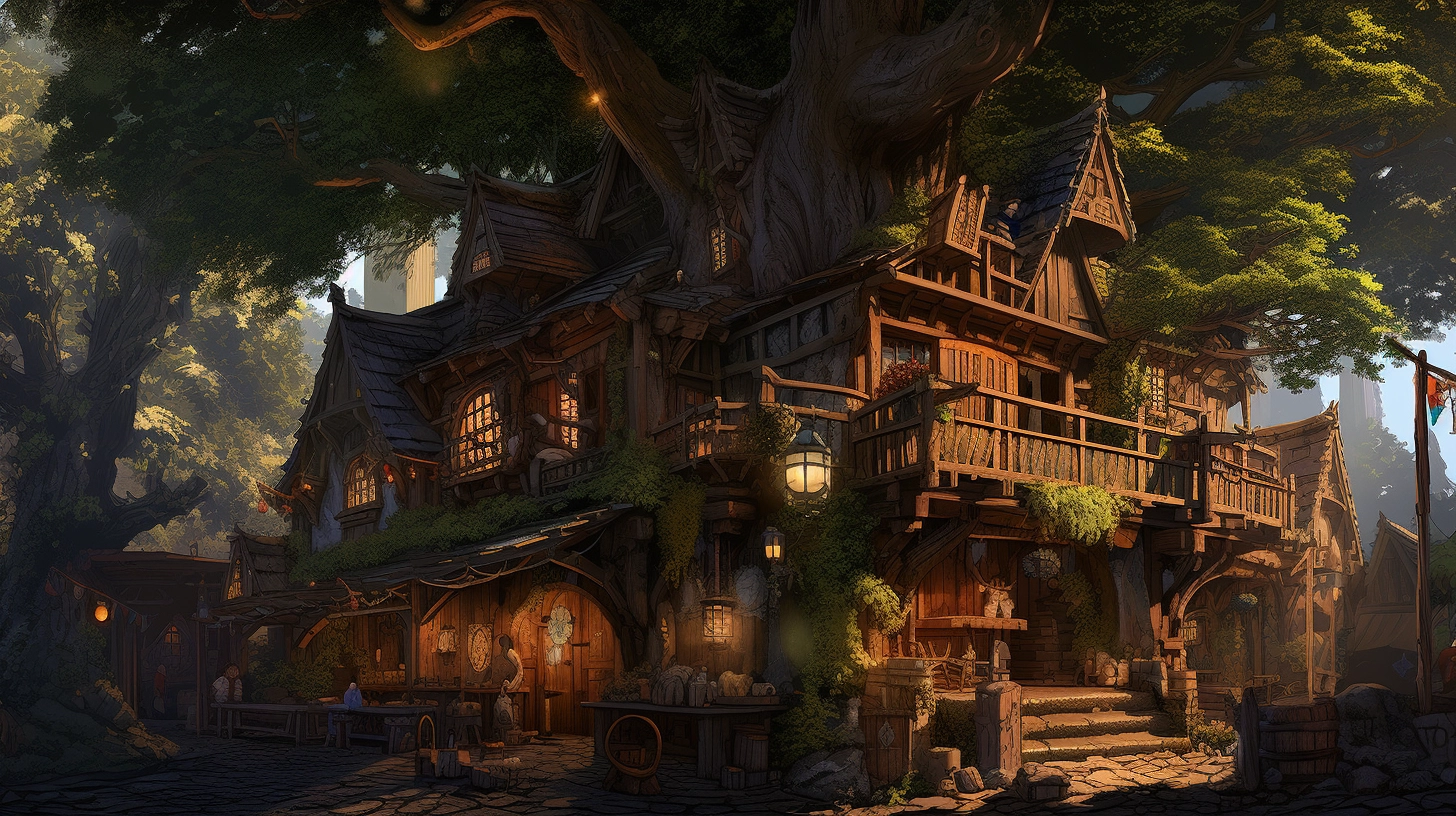
Ah, the Whispering Willow! Or just ‘The Willow’ if you’re trying to sound casual while nursing a frothy mug. This isn’t just any old tavern in Aurel’s Reach; it’s the place where half of my mischief has started… and maybe about a quarter of it has ended.
Exterior
Perched right against the city’s imposing northern wall and merging with that magnificent redwood – it’s almost as if nature herself decided to raise a toast! From one side, you have the lively humdrum of the city, while the other gives you that calming rustle of the Eldergrove forest. Imagine being sandwiched between urban energy and tranquil nature, all while you’re sipping your third – or was it fourth? – mug of Bardin’s special brew.
Now, on the outside, The Willow seems like your classic tree-tavern architecture. A three-story wonder nestled right inside that monstrous redwood. If you lean against its bark, sometimes, on a windy day, you’d swear you can hear the old tree whispering. Probably telling the wood nymphs about the one time I spilled an entire plate of honey-roasted nuts all over a passing elven bard. But branching out (hah!), we have the two annexed buildings. One of them, I heard, is where they keep the extra barrels of ale, and trust me, it’s on my bucket list to sneak a peek. The other, rooms for those lucky enough to fetch them, or too drunk to haggle the price.
Inside
Stepping inside? Ah, it’s like wrapping yourself in a warm, golden hug! A kaleidoscope of lanterns and glowing orbs dangle overhead, probably gossiping about the day’s visitors. The furniture? Rich, ornately carved, probably by some master craftsman – though I once told a traveler it was done by a blindfolded elf with a penchant for abstract art. And those tapestries? They’re not just decorative fabric; they are pages right out of Eldergrove’s history, each thread spun with tales of yore. I’ve tried to ask Marna how the willow could afford these stories in thread and she just tells me “clearly you don’t keep an eye on your tab, Rye!”
The Food and Drink
Now, for the culinary enthusiasts (yes, I’m talking about my belly), the gastronomic wonders of this place deserve a saga of their own! The succulent roasted boar, glazed in a secret sauce, and that mouth-watering blueberry pie… Trust me, you haven’t lived till you’ve paired that with Bardin’s cinnamon spiced mead.
Rumor whispers of a fiercely loyal kitchen brigade, headed by Chef Olrin, an enigmatic half-elf with a flair for turning the mundane into the magnificent. A sprig of herb here, a dash of mysterious spice there, and voila, a dish fit for the courts of kings!
The Staff
Speaking of Bardin, ah, the dwarf with a beard as frothy as his drinks! He doesn’t just serve drinks; he serves legends in a cup. Every mug comes with a story, and if you’re lucky, an anecdote about that time a gnome tried to outdrink an ogre.
Beside him, the radiant heart of this establishment, Marna. That woman could coax a smile out of a grumpy stone golem. With a knack for making everyone feel like they’ve returned home, I reckon she knows a spell or two about hospitality.
And then, there’s Maria. Delicate yet fierce, she’s a wonder. From the gnome settlement of Silverbrook, deep in the hidden canyon south of the falls, she graces us with tales from her home-caves. Her passion for wines and good smokes is only rivaled by her knack for befriending even the most peculiar of guests. Case in point, the evening a troll - lost, hungry, and irate - stumbled into The Willow. While the initial chaos sent mugs flying and patrons scurrying - you can see where its claws scratched through Old Martin’s fresco of The Blood Matriark’s Gift, changing the story, but in a sort of delightful way if you’ve enough imagination! - Maria, with an odd blend of calm and charisma, managed not only to soothe the beast but had him humming a gnome lullaby by the end of the night.
The Patrons
As the sun dozes off, The Willow becomes one of Eldergrove’s hidden respites for the lumberjacks returning from months long turns, to the little lords and ladies who’ve escaped their guards’ watch, to the clever beggars who’ve filled their purse, and plenty of strangers, enigmatic and boisterous from lands afar and deep in the Elderwood.
The melodious tunes, the boisterous tales, the foot-tapping beats – every corner is brimming with life. The tavern never closes and it seems there’s always someone raising a toast, although, in the wee hours of the morning, it’s mostly just itinerate owlbears and night-elves… and me.
Lodging
There’s everything available for those who ride in the palanquin to those who carry it.
Ah, the rooms of The Willow – spaces of reprieve, reflection, and respite. Their variety is, in a way, a testament to the tapestry of life itself, where every thread finds its place, no matter how rich or rugged.
For the weary traveler, whose purse may be light yet spirit undeterred, the welcoming aroma of the stables often provides a humble berth. There’s a sweet, earthy smell that permeates these quarters, reminding one of simpler times and starlit journeys. It’s the scent of adventure, of roads taken and yet to be tread.
However, for those with deeper pockets and tastes honed by the refined alleys of royal courts, The Willow offers chambers that are nothing short of opulent. Silks from the distant East, in hues of gold, azure, and crimson, drape every possible corner. The gentle rustle of these fabrics, combined with the soft glow of enchanted lanterns, transports the occupant to a realm of sheer luxury, fit for the traveling ladies and lords who grace the realms aboard majestic palanquins.
But The Willow understands the diversity of its patrons. Between the rustic allure of the stables and the lavish embrace of silk-clad rooms, lie spaces of myriad designs. Some rooms are tailored for the minstrels, where soft melodies from an unseen lute might echo in the hush of dawn. Others, perhaps, are for the scholar, with sturdy oak desks and shelves lined with scrolls and tomes from yesteryears.
A unique feature, one that often stirs whispers among those who like to tread the fine line of legality, is the positioning of several rooms. Many hang precariously, albeit securely, just over the city wall. Their discreet balconies and hidden passages grant occupants a certain freedom – the ability to come and go without the watchful eyes of the city guard casting judgment. Such rooms have seen merchants and rogues, diplomats and spies, all seeking the subtle blend of discretion and luxury.
And in this labyrinth of chambers and halls, there’s my sanctuary – a secluded corner room. Neither opulent nor humble, it’s a space where the worlds meet. From its vantage, one can gaze upon the bustling heartbeats of Aurel’s Reach and, with a slight turn, lose oneself in the timeless embrace of the forest. It’s where musings turn to tales, and tales to legacies.
The Feel
One might wonder, with the ceaseless inflow of patrons, from the giddy jester to the somber knight, how does The Willow maintain its allure? It’s in the details, my friend. From the gnome-crafted Glitterleaf Maria introduces to the curious, to the rumored ghost of a bard that serenades the lonely, The Whispering Willow isn’t just a tavern. It’s an experience, a journey, an ever-unfolding story in the heart of Aurel’s Reach.
So, if you ever find yourself in Aurel’s Reach and yearn for a night of stories, laughter, and perhaps a touch of mischief – or just a bellyful of fantastic grub – you know where to go. Tell them I sent you, but only if you leave good tips.
Major NPCs
- Maria, Gnome Waitress AC: 12. HP: 10. Speed: 25 ft. STR: 8, DEX: 14, CON: 12, INT: 15, WIS: 14, CHA: 17. Skills: Persuasion +6, Insight +3.
- Marna, human innkeeper. AC: 12. HP: 10, Speed: 30 ft. STR: 10 DEX: 14 CON: 12 INT: 13 WIS: 15 CHA: 17. Skills: Persuasion +5, Insight +4 Actions: Slap: +2 to hit, reach 5 ft., one creature.
- Bardin, Dwarf Bartender AC: 11. HP: 10, Speed: 25 ft. STR: 14 DEX: 12 CON: 16 INT: 10 WIS: 13 CHA: 14. Skills: History +2, Perception +3.
A Glimpse into Maria’s Life
Among the tavern’s many vibrant personalities, Maria stands out, not for her stature - for she is but a gnome - but for her captivating presence and tales that trace back to the shadowy depths of Silverbrook.
Hailing from this neighboring gnome settlement, nestled in the heart of a forested canyon, Maria’s journey to Aurel’s Reach was driven by an unquenchable thirst for knowledge about wines. With dreams of one day returning to Silverbrook to establish her own tavern, she absorbs all she can from The Whispering Willow’s patrons and its vast cellar.
In the midst of her siblings - six in total - Maria’s role as the middle child has perhaps granted her the patience to listen and the flair to weave tales. Her stories, often exchanged for a patron’s own or even for a modest tip, add a unique flavor to the Willow’s nightly entertainment.
Whispers often circulate about Maria’s trove of trinkets, treasures gifted by travelers or picked up from distant lands. The centerpiece of this collection is a silver pendant of curious design. Though many have prodded, she remains tight-lipped about its origin, furthering the air of mystery around her.
Yet, her most prized possession is not a trinket but a tobacco, the rare Tobacco Glitterleaf. Unique to the shadowy alcoves of Silverbrook’s caves, this non-magical plant dazzles onlookers with its shimmer, a reflection of the mineral-rich soils of its birthplace. When smoked, it’s not just the tobacco that’s shared, but a time-honored gnome tradition symbolizing unity and deep contemplation. In the caverns of Silverbrook, amidst echoing tales and the play of dim lights, this tradition persists, a symbol of the enduring spirit and unity of the gnomish community.
At The Whispering Willow, Maria is not just a waitress but a bridge to a world unknown, a subterranean realm of stories, traditions, and the sparkle of Glitterleaf.
Encounters
d20 Possible Patrons in the Tavern
- Old Thom: A wrinkled man recounting tales of dragons. Hook: He once stole a dragon egg and it’s about to hatch.
- Lila the Bird Lady: An elven woman speaking to her pet bird. Hook: The bird is a polymorphed prince.
- Bruun: A hefty man challenging folks to arm wrestling. Hook: His strength is from a cursed gauntlet.
- Lady Annelise: A noblewoman incognito, observing. Hook: She seeks a bodyguard for a covert mission.
- Fletcher: A man selling maps. Hook: One map leads to a forgotten city.
- Bria: A girl crying, lost from her family. Hook: Her family was abducted by goblins.
- Norgal: A half-troll boasting loudly. Hook: He wants to find and challenge his full troll father.
- The Hooded Figure: A mysterious entity in the shadows. Hook: They are a time traveler with a warning.
- Sir Cedric: A retired knight, now a drunk. Hook: His haunted past calls him for one last quest.
- Twins Lora and Lona: Synchronized in every action. Hook: They share a psychic bond due to a magical experiment.
- Faelan: A minstrel with a harp, avoiding eye contact. Hook: His songs can predict the future.
- Jara: A merchant selling odd seeds. Hook: These seeds grow into sentient plants.
- The Cursed Poet: Speaks only in rhymes. Hook: Needs help breaking a witch’s curse.
- Captain Elin: A sea captain recruiting. Hook: Her ship sails to the underworld and back.
- Lilith: A young woman, surrounded by cats. Hook: She’s seeking a rare herb for her ailing familiar.
- Merek the Mute: Communicates via drawings. Hook: His sketches can become real for a short time.
- Doran: A scholar looking exasperated. Hook: Accidentally awakened a slumbering entity in an old tome.
- Sera: A dancer with a snake. Hook: The snake is her twin, transformed by an enemy.
- Peldor the Jester: Cracking jokes. Hook: His humor hides a tragic story he’s willing to share for the right price.
- Glenna: A gardener with flowers. Hook: Her garden has a portal to the Feywild, and she needs protection.
Rye Leafoot's Guide to Elderwood: Aurel's Reach
At the very heart of the Elderwood, Aurel’s Reach unfurls. Envision the central region of the Elderwood map: this is the Eldergrove, the verdant heart where Aurel’s Reach proudly stands. Its origins remain a mystery to me, yet over countless centuries, it’s blossomed to accommodate a lively 15,000 souls. The city sprawls gracefully alongside a serene, straight stretch of the river, which some say lent its name to the town.
Debate flourishes over the eponymous ‘Aurel’. Was he a pioneering explorer, the city’s founder, or perhaps the river’s original namesake? Only the whispers of ancient trees might tell.
The city’s vastness mingles seamlessly with the forest, a dance of wood, stone, and greenery. One can’t help but notice the distinct Old Town, ensconced behind high walls, evoking ages past with its robust towers and gates. It’s a clear nod to traditional city planning, standing in stark contrast to the rest of Aurel’s Reach, which exudes a more…organic ambiance.
As the years rolled by, the inhabitants took a delightfully eclectic approach to expansion. Their choice of materials and seemingly spontaneous design decisions lend the city a unique, bricolage essence. This delightful architectural marriage ensures the city and forest blend so intricately, it’s hard to discern where one ends and the other begins. Roads and buildings, over time, have harmoniously co-evolved with the trees and groves. Despite the city walls, I’ve often felt navigating the dense Elderwood was simpler than maneuvering through the labyrinthine alleys of Aurel’s Reach.
One might surmise that the Old Town was the meticulous work of high elves, while the remainder of the city seems inspired by what little an Illithid left in the mind of a genius gnome tinkerer. All in all, wandering its streets evokes the same joy as savoring a masterfully prepared 11-course Elderwood feast.
Rye Leafoot's Guide to Elderwood: Introduction from the Bird's Eye
Elderwood. Ah, dear reader, it’s so much more than a mere word on parchment. It’s the delicate shiver of leaves under a morning breeze, the deep-rooted tales older than the oldest oak, and the harmonious symphony of bustling life and placid landscapes.
To the north, run a mountain range, The Elf’s Wall. These peaks casts lengthy shadows, towering sentinels of age-old stone that I’ve often found myself wondering about. How many stories have they witnessed, unchanging and eternal, as empires rose and fell? But just between you and me, tucked in the east, there’s a sneaky passage. If walls could talk, eh?
Down these mountains, the flora paints a verdant scene so lush that even the most skilled painter might surrender his brush in awe. I once met an old dwarf who claimed his ancestors mistook this place for the Feywild, and who’s to blame them? The trees stretch so thickly, it’s as if the ground is playing an endless game of “more the merrier.”
Now, let’s chat about that life-giving river, a liquid ribbon gracefully meandering from the northeast. There’s a bit of predictability in its course, straightening up with purpose around Aurel’s Reach. Ah, that city! Nestled where the river seems to take a calm breath before diving into its next adventure. The hub of timber trade, it’s a city that knows its wood like a bard knows his lute.
Speaking of Aurel’s Reach, imagine a place where the sounds of hammers and song blend seamlessly. A mosaic of cultures — humans, halflings (like yours truly), elves, and so many more — each contributing a note to the city’s harmonious tune. The river divides yet connects, its bridges reminiscent of friendships formed over shared ale and campfires. Across the waters, the farmlands. Oh, the patchwork beauty! Each plot telling tales of hard work and nature’s bounty.
But let’s take a little detour, for my wandering heart calls. To the west, the forests give way to plains, vast and unending. These plains stretch out like a bard’s tale, eventually leading to the Royal Coast that caresses the enigmatic Sea of Passage. Ah, the sea! A force that’s both nurturing and wild. I once heard an elf sing of its tales; of its moods that range from serene lulls to tempestuous roars.
Back to Elderwood, though. The symbiotic dance between civilization and nature here is a thing of beauty. The denizens, respectful of the forest’s whispers, and the forest, ever watchful, sometimes peeking with curious eyes at the bustling life beyond its embrace.
For every timber merchant counting his coin, there’s a nymph singing an ancient song; for every halfling child chasing fireflies, there’s a treant reminiscing tales of old. It’s harmony, in its purest form.
As for the denizens of this rich land, they’re a reflection of Elderwood’s spirit — vibrant, diverse, and rooted in age-old traditions. Tales of timber, magic, and camaraderie echo in every corner. There’s depth beneath the surface, waiting for the curious soul to discover.
And as Rye Leafoot, the ever-curious halfling druid, I invite you to take this journey with me, to delve deeper into the heart of Elderwood, and perhaps, just perhaps, discover a piece of yourself amidst its tales.
